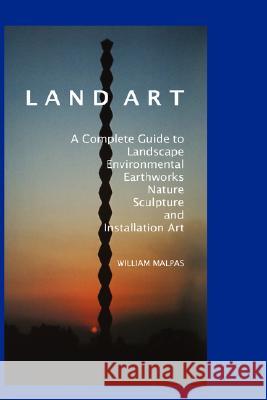Land Art: A Complete Guide to Landscape, Environmental, Earthworks, Nature, Sculpture and Installation Art » książka
Land Art: A Complete Guide to Landscape, Environmental, Earthworks, Nature, Sculpture and Installation Art
ISBN-13: 9781861712325 / Angielski / Twarda / 2008 / 376 str.
Land Art: A Complete Guide to Landscape, Environmental, Earthworks, Nature, Sculpture and Installation Art
ISBN-13: 9781861712325 / Angielski / Twarda / 2008 / 376 str.
(netto: 214,84 VAT: 5%)
Najniższa cena z 30 dni: 224,96
ok. 16-18 dni roboczych
Dostawa w 2026 r.
Darmowa dostawa!
LAND ART
A fully illustrated guide to land and environmental art.
For the land artist, the whole planet is an artist's studio. The land artist ranges over the whole globe. A desert, a beach, a field, a forest becomes a studio, a place of creative activity. This means the very texture and colour and shape and dampness and springiness and strength and size of moss, for instance. Or a stone. Or a crevice in a rock formation. The way the light falls on a patch of grass, the little bits of dead, yellowish grass on top of the newer, green grass. Pine cones, closed-up. Flowers turning sunward in the late afternoon. These are the things land artists deal with in making art. These are the actualities that artists employ when they create artworks. ?
This new book explores all of the major land, environmental and earthwork artists of the past 40 years, including James Turrell and his vast volcano site Hans Haacke's Conceptual art Michael Heizer's Mid-West earthworks Robert Smithson and his giant spiral, entropic earthworks Christo's wrapped buildings and islands, Robert Morris's environments Walter de Maria's Romantic Lightning Field David Nash's stoves, stones, trees and North Wales environments Hamish Fulton's walks and words Dennis Oppenheim's concentric snow circles Richard Long and his art of walking Andy Goldsworthy's natural, spontaneous, eco-friendly sculptures Alice Aycock's mysterious underground mazes Mary Miss's sunken pools and pavilions Wolfgang Laib's delicate, luminous pollen spreads Nancy Holt and her observation sculptures and the enigmatic floor sculptures of Carl Andre.
Here are towers, stars, stones, pools, tunnels, pipes, maps, chasms, ladders, mounds, scars, mirrors, cones, furrows, mazes, circles, hills and gardens. ?"
LAND ART
A fully illustrated guide to land and environmental art.
For the land artist, the whole planet is an artists studio. The land artist ranges over the whole globe. A desert, a beach, a field, a forest becomes a studio, a place of creative activity. This means the very texture and colour and shape and dampness and springiness and strength and size of moss, for instance. Or a stone. Or a crevice in a rock formation. The way the light falls on a patch of grass, the little bits of dead, yellowish grass on top of the newer, green grass. Pine cones, closed-up. Flowers turning sunward in the late afternoon. These are the things land artists deal with in making art. These are the actualities that artists employ when they create artworks.
?This new book explores all of the major land, environmental and earthwork artists of the past 40 years, including James Turrell and his vast volcano site • Hans Haackes Conceptual art • Michael Heizers Mid-West earthworks • Robert Smithson and his giant spiral, entropic earthworks • Christos wrapped buildings and islands, • Robert Morriss environments • Walter de Marias Romantic Lightning Field • David Nashs stoves, stones, trees and North Wales environments • Hamish Fultons walks and words • Dennis Oppenheims concentric snow circles • Richard Long and his art of walking • Andy Goldsworthys natural, spontaneous, eco-friendly sculptures • Alice Aycocks mysterious underground mazes • Mary Misss sunken pools and pavilions • Wolfgang Laibs delicate, luminous pollen spreads • Nancy Holt and her observation sculptures • and the enigmatic floor sculptures of Carl Andre.
Here are towers, stars, stones, pools, tunnels, pipes,maps, chasms, ladders, mounds, scars, mirrors, cones, furrows, mazes, circles, hills and gardens.
?










